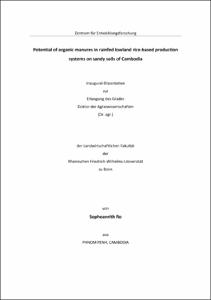The Faculty of Agricultural, Nutritional and Engineering Sciences: Search
Now showing items 1-1 of 1
Potential of organic manures in rainfed lowland rice-based production systems on sandy soils of Cambodia
(2016-04-25)
Rainfed lowland rice is the dominant food crop in the low-input agricultural systems of Cambodia. The main production area is characterized by sandy soils with low contents in nitrogen, phosphorus and organic matter, as ......
Potenzial organischer Dünger in Reisanbausystemen auf sandigen Böden im Tiefland von Kambodscha
Regengespeister Nass-Reis ist das vorherrschende angebaute Nahrungsmittel in extensiven Agrarsystemen ......
Potenzial organischer Dünger in Reisanbausystemen auf sandigen Böden im Tiefland von Kambodscha
Regengespeister Nass-Reis ist das vorherrschende angebaute Nahrungsmittel in extensiven Agrarsystemen ......



